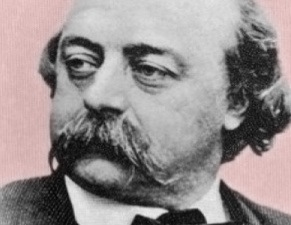
Gustave Flaubert, always in pursuit of le mot juste, devoted a week’s worth of twelve hour days to the crafting of a single page. He dedicated seven years to the masterpiece Madame Bovary; The Temptation of Saint Anthony occupied him for twenty-five. Here he addresses Mme Leroyer, another provincial writer, and discusses his saintly protagonist’s spiritual and material conditionings. Flaubert’s venturing into the uncharted anatomies of “the human heart” would not win the critics’ approval; the novel was resoundingly condemned when published in 1872.
To Mademoiselle Leroyer de Chantepie
Croisset, February 18, 1859
It’s a sad story about your relative, the girl driven insane by religious ideas, but not an uncommon one. A robust constitution is needed if one is to scale the peaks of mysticism without losing one’s head. And then the whole thing involves (especially for women) questions of temperament, which complicate the malady. Don’t you see that they are all in love with Adonis? The eternal bridegroom is what they yearn for. Whether ascetic or lustful, they dream of love, le grand amour; and in order to be cured (at least temporarily) what they need is not an idea, but something tangible—a man, a child, a lover. That may sound cynical to you. But human nature is not my invention. I am convinced that the most raging material appetites express themselves unwittingly in outbursts of idealism, just as the most obscene carnal expressions are engendered by pure desire for the impossible, ethereal aspiration toward supreme bliss. Besides, neither I nor anyone else knows the meaning of those two words: “soul” and “body”—nor where one leaves off and the other begins. We are aware of certain drives, and that is all. Materialism and spiritualism still weigh too heavily on the study of man to permit an impartial investigation of all these phenomena. The anatomy of the human heart is as yet uncharted. So how can you expect it to be cured? To have embarked on such studies will remain the nineteenth century’s sole claim to fame. The historical sense is a very new thing in the world. Ideas will now be studied like facts; beliefs dissected like organisms. There exists an entire school that is quietly working on these things, and it will bring results, I am sure.
Did you read Renan’s splendid books? Do you know Lanfrey’s, or Maury’s?
I have had occasion recently to return to those psychomedical studies that so fascinated me ten years ago, when I was [first] writing my Saint Anthony. In connection with my Salammbô I have been investigating hysteria and mental derangement. There are treasures to be discovered in those fields. But life is short and Art is long, indeed nearly impossible when one is writing in a language that is worn to the point of being threadbare, so worm-eaten that it frays at every touch. What discouragement, what anguish, the love of Beauty brings! Besides—I have undertaken something that is unachievable. No matter: if I stimulate a few noble imaginations I’ll not have wasted my time. My task is about a quarter done. Still two years’ work ahead.
Notes: Lanfrey served as an officer in Napoleon’s army, and would later write an expansive biography of the emperor. Jean-Sifrein Maury, made famous for his panegyric on Saint Louis, was an archbishop well known for his wit and gaiety.
From The Letters of Gustave Flaubert: 1857–1880. Edited by Francis Steegmuller. Cambridge: Belknap Press, 1982, p. 15–16.
FURTHER READING
Odilon Redon imagines the redemption of Saint Anthony.
The meticulous daily routine.
Ernest Renan and the history of Christianity.


